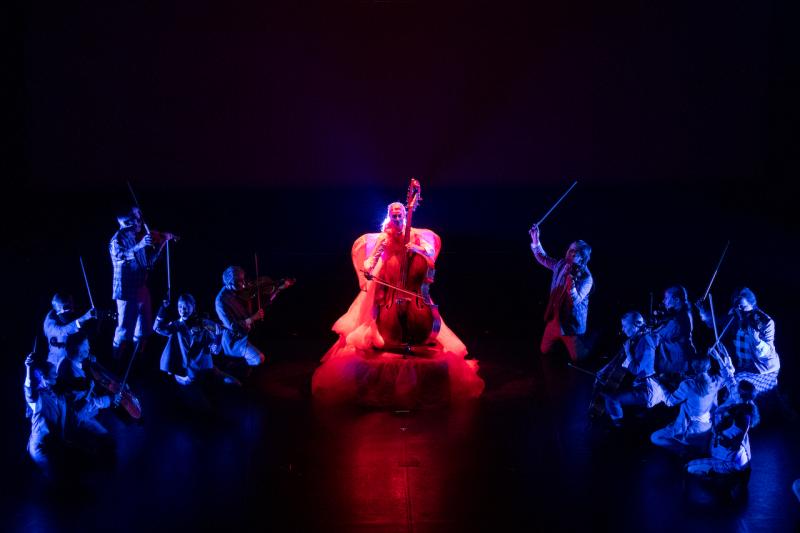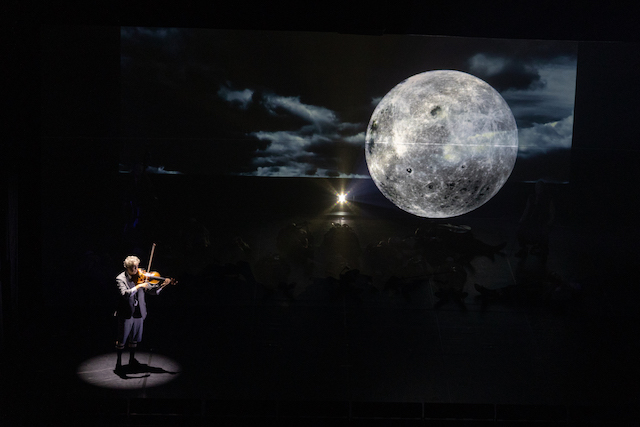Concert Theatre DSCH, Norwegian CO, QEH review - visually stunning, viscerally thrilling Shostakovich | reviews, news & interviews
Concert Theatre DSCH, Norwegian CO, QEH review - visually stunning, viscerally thrilling Shostakovich
Concert Theatre DSCH, Norwegian CO, QEH review - visually stunning, viscerally thrilling Shostakovich
Wildly inventive staging, combining choreography and lighting, is a total triumph

This luminously persuasive, radically inventive performance of Shostakovich’s music begins – quite literally – at the end. Beneath a slowly revolving monochrome moon, a lone musician delivers a plangent rendition of the Moderato and Allegretto from the final viola sonata the composer wrote before dying of cancer in 1975.
The electrically compelling Finnish violinist Pekka Kuusisto has collaborated with Danish director Mikkel Harder Munck-Hansen to produce a very different take on the composer who wrote many of his greatest works under the shadow of Stalin. Rather than taking the obvious route of politicising this staging of his works, they have built a haunting dreamscape in which Kuusisto along with members of the Norwegian Chamber Orchestra appear as otherworldly figures, completely possessed by the music they play.
Sometimes the mood’s subversive, almost comedic, at others it’s more philosophical. What’s most striking is that the entire ensemble has memorised almost twenty works so that their communication with each other is uninhibited. The choreography demands that they dart in and out of each other, on occasions wearing masks, always changing formation between pieces and sometimes even between phrases. The result is a technically impressive, viscerally thrilling survey of Shostakovich’s work. Pale makeup which exaggerates the musicians’ eyes and cheekbones along with rag tag tartan costumes means that sometimes the players look like clowns, at others like fugitives, at others like ghosts.  The programme as a whole is built around the musical motif DSCH (D, E flat, C, B natural) that Shostakovich often used in his works as a leitmotif from the German spelling of his name. From the viola sonata, we’re swept into a performance of the Romance from the composer’s score for the 1955 film The Gadfly – in which the entire ensemble, lit in red, rises up in front of a backdrop that looks like a manic spider’s web. Then a more measured atmosphere prevails as a grid is projected onto the stage, and a shadow dancer – echoed by a filmed image at the back – loops across the grid to the accompaniment of the Polka from Shostakovich’s Three Fantastic Dances.
The programme as a whole is built around the musical motif DSCH (D, E flat, C, B natural) that Shostakovich often used in his works as a leitmotif from the German spelling of his name. From the viola sonata, we’re swept into a performance of the Romance from the composer’s score for the 1955 film The Gadfly – in which the entire ensemble, lit in red, rises up in front of a backdrop that looks like a manic spider’s web. Then a more measured atmosphere prevails as a grid is projected onto the stage, and a shadow dancer – echoed by a filmed image at the back – loops across the grid to the accompaniment of the Polka from Shostakovich’s Three Fantastic Dances.
Certain numbers, inevitably, stand out. Not least the Allegretto from the Seventh String Quartet, in which the musicians appear to be passengers on a train speeding through silver birch woods, continuously swapping seats to change musical conversations. Following this the aesthetic shifts dramatically, as Katrine Sonstad – who co-conceptualised the concert’s staging – appears centre stage with her double bass, dressed in red like a fiery angel.
In the performance of the Allegretto from the Second Cello Concerto that ensues, there are many occasions when the bass is drawn into an intense, lyrical dialogue with accordionist Bjarke Mogensen. Among many other of its aspects, this concert really emphasises the full expressive potential of the accordion – frequently it appears as a substitute for the piano, and Mogensen compellingly demonstrates how it has both the gravitas and poetic range to do so.
The longest piece, by some measure, is the 20-minute performance of the Chamber Symphony arranged by Rudolf Barshai from the Eighth String Quartet in front of projections of rolling clouds in a bruise-coloured sky, the orchestra excavates all the symphony’s despair and quiet rage. Øystein Sonstad’s expressive cello playing in particular takes centre stage as the notes resonate like a desolate prayer to a fate that he cannot control.
The programme announces proudly that this is a “concert unlike any other”, and that’s undeniable. The considerable demands that it imposes on the musicians, not just musically but also physically, means that it is unlikely to have imitators any time soon. All the more reason to rush to see it whenever you have the opportunity, to experience it in all its beguiling, fiercely intelligent originality. A searing triumph.
- Read more reviews on the arts desk
- Pekka Kuusisto will next be performing Mahler at the Tonnhalle in Zürich
rating
Explore topics
Share this article
Add comment
The future of Arts Journalism
You can stop theartsdesk.com closing!
We urgently need financing to survive. Our fundraising drive has thus far raised £49,000 but we need to reach £100,000 or we will be forced to close. Please contribute here: https://gofund.me/c3f6033d
And if you can forward this information to anyone who might assist, we’d be grateful.

Subscribe to theartsdesk.com
Thank you for continuing to read our work on theartsdesk.com. For unlimited access to every article in its entirety, including our archive of more than 15,000 pieces, we're asking for £5 per month or £40 per year. We feel it's a very good deal, and hope you do too.
To take a subscription now simply click here.
And if you're looking for that extra gift for a friend or family member, why not treat them to a theartsdesk.com gift subscription?
more Classical music
 Classical CDs: Voice flutes, flugelhorns and froth
Baroque sonatas, English orchestral music and an emotionally-charged vocal recital
Classical CDs: Voice flutes, flugelhorns and froth
Baroque sonatas, English orchestral music and an emotionally-charged vocal recital
 Kanneh-Mason, Britten Sinfonia, Shave, Milton Court - a grin and a big beaming smile
A pair of striking contemporary pieces alongside two old favourites
Kanneh-Mason, Britten Sinfonia, Shave, Milton Court - a grin and a big beaming smile
A pair of striking contemporary pieces alongside two old favourites
 theartsdesk at the New Ross Piano Festival - Finghin Collins’ musical rainbow
From revelatory Bach played with astounding maturity by a 22 year old to four-hand jazz
theartsdesk at the New Ross Piano Festival - Finghin Collins’ musical rainbow
From revelatory Bach played with astounding maturity by a 22 year old to four-hand jazz
 First Person: Manchester Camerata's Head of Artistic Planning Clara Marshall Cawley on questioning the status quo
Five days of free events with all sorts of audiences around Manchester starts tomorrow
First Person: Manchester Camerata's Head of Artistic Planning Clara Marshall Cawley on questioning the status quo
Five days of free events with all sorts of audiences around Manchester starts tomorrow
 Goldscheider, Brother Tree Sound, Kings Place review - music of hope from a young composer
Unusual combination of horn, strings and electronics makes for some intriguing listening
Goldscheider, Brother Tree Sound, Kings Place review - music of hope from a young composer
Unusual combination of horn, strings and electronics makes for some intriguing listening
 theartsdesk Q&A: composer Donghoon Shin on his new concerto for pianist Seong-Jin Cho
Classical music makes its debut at London's K-Music Festival
theartsdesk Q&A: composer Donghoon Shin on his new concerto for pianist Seong-Jin Cho
Classical music makes its debut at London's K-Music Festival
 Helleur-Simcock, Hallé, Wong, Bridgewater Hall, Manchester review - moving lyricism in Elgar’s concerto
Season opener brings lyrical beauty, crisp confidence and a proper Romantic wallow
Helleur-Simcock, Hallé, Wong, Bridgewater Hall, Manchester review - moving lyricism in Elgar’s concerto
Season opener brings lyrical beauty, crisp confidence and a proper Romantic wallow
 Kohout, Spence, Braun, Manchester Camerata, Huth, RNCM, Manchester review - joy, insight, imagination and unanimity
Celebration of the past with stars of the future at the Royal Northern College
Kohout, Spence, Braun, Manchester Camerata, Huth, RNCM, Manchester review - joy, insight, imagination and unanimity
Celebration of the past with stars of the future at the Royal Northern College
 Jansen, LSO, Pappano, Barbican review - profound and bracing emotional workouts
Great soloist, conductor and orchestra take Britten and Shostakovich to the edge
Jansen, LSO, Pappano, Barbican review - profound and bracing emotional workouts
Great soloist, conductor and orchestra take Britten and Shostakovich to the edge
 Jakub Hrůša and Friends in Concert, Royal Opera review - fleshcreep in two uneven halves
Bartók kept short, and a sprawling Dvořák choral ballad done as well as it could be
Jakub Hrůša and Friends in Concert, Royal Opera review - fleshcreep in two uneven halves
Bartók kept short, and a sprawling Dvořák choral ballad done as well as it could be

Comments
I'm not seeing the usual
I'm not seeing the usual review information of TDP: time, date, place. I'll do a search, but I imagine other readers would also like to be able to see it here. Thanks for any assistance!
That's because there were
That's because there were only two performances, on Saturday and Sunday. If we find out that it's being performed elsewhere, we'll add that information. Worth travelling a long way to see...